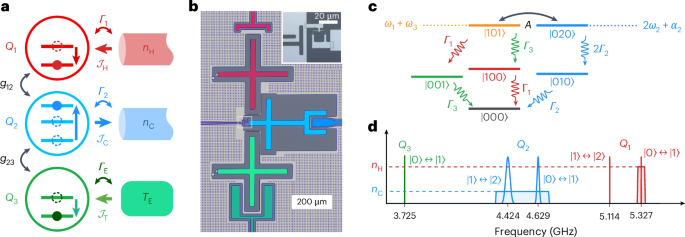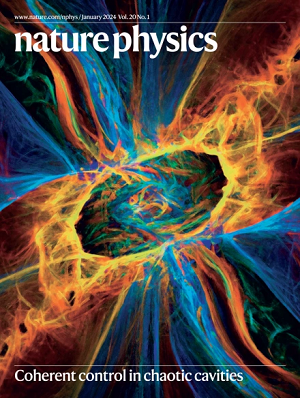热驱动量子制冷机自动重置超导量子比特
IF 17.6
1区 物理与天体物理
Q1 PHYSICS, MULTIDISCIPLINARY
引用次数: 0
摘要
虽然经典热机为工业和现代生活提供动力,但量子热机尚未证明其实用性。在这里,我们展示了一个有用的由超导电路形成的量子吸收制冷机。我们用它来冷却一个transmon量子位,使其温度低于任何一种可用的浴池所能达到的温度,从而将量子位重置为适合量子计算的初始状态。该过程由热梯度驱动,是自主的,不需要外部反馈。冰箱利用了目标量子比特和两个辅助量子比特之间的工程三体相互作用。每个辅助qudit都耦合到一个物理热浴,用一个含有合成准热辐射的微波波导来实现。如果目标量子比特最初被完全激发,其有效温度将达到约22 mK的稳态水平,低于现有最先进的重置协议所能达到的水平。我们的研究结果表明,具有传播热场的超导电路可以用于实验探索量子热力学并将其应用于量子信息处理任务。本文章由计算机程序翻译,如有差异,请以英文原文为准。


Thermally driven quantum refrigerator autonomously resets a superconducting qubit
Although classical thermal machines power industries and modern living, quantum thermal engines have yet to prove their utility. Here, we demonstrate a useful quantum absorption refrigerator formed from superconducting circuits. We use it to cool a transmon qubit to a temperature lower than that achievable with any one available bath, thereby resetting the qubit to an initial state suitable for quantum computing. The process is driven by a thermal gradient and is autonomous, requiring no external feedback. The refrigerator exploits an engineered three-body interaction between the target qubit and two auxiliary qudits. Each auxiliary qudit is coupled to a physical heat bath, realized with a microwave waveguide populated with synthesized quasithermal radiation. If the target qubit is initially fully excited, its effective temperature reaches a steady-state level of approximately 22 mK, lower than what can be achieved by existing state-of-the-art reset protocols. Our results demonstrate that superconducting circuits with propagating thermal fields can be used to experimentally explore quantum thermodynamics and apply it to quantum information-processing tasks. Resetting qubits in a quantum computer requires significant hardware resources. Now, an experiment demonstrates an on-chip quantum refrigerator that uses a thermal gradient to reset a superconducting qubit more effectively than conventional methods.
求助全文
通过发布文献求助,成功后即可免费获取论文全文。
去求助
来源期刊

Nature Physics
物理-物理:综合
CiteScore
30.40
自引率
2.00%
发文量
349
审稿时长
4-8 weeks
期刊介绍:
Nature Physics is dedicated to publishing top-tier original research in physics with a fair and rigorous review process. It provides high visibility and access to a broad readership, maintaining high standards in copy editing and production, ensuring rapid publication, and maintaining independence from academic societies and other vested interests.
The journal presents two main research paper formats: Letters and Articles. Alongside primary research, Nature Physics serves as a central source for valuable information within the physics community through Review Articles, News & Views, Research Highlights covering crucial developments across the physics literature, Commentaries, Book Reviews, and Correspondence.
 求助内容:
求助内容: 应助结果提醒方式:
应助结果提醒方式:


